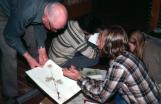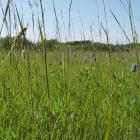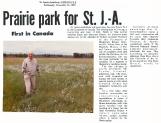1
I became the Chairman, and later the Co-chair of the IBP (CT) in Manitoba, in I think, 1966, and immediately set up an Ecological Advisory Committee. Its members included:Mr. G.W. Malaher Chief of the Provincial Wildlife Branch
Mr. J.H. Ellis Soils Dept. University of Manitoba
Dr. R. Nero Manitoba Museum
Mr. C.B. Gill Forestry, Province of Manitoba
and perhaps others, but I can't remember who.
2
Plant identification at the Living Prairie MuseumJune, 1982
2795 Ness Ave, Living Prairie Museum, St. James, Winnipeg, Manitoba, Canada

3
Aware of the objectives of the IBP (CT) our aim was:*to promote public understanding of, and support for, the establishment of a comprehensive Canadian system of protected ecological areas.
*to priorize the Manitoba sites that we thought should be inventoried.
*to inventory candidate sited and secure their protection.
4
The tall grass prairie in the height of summer.8 March 2004
Living Prairie Museum, St. James, Winnipeg, Manitoba, Canada

5
We soon concluded that tall grass prairie was the most endangered ecosystem in the Province, as all but a very small percentage had been ploughed.Where to start? I wrote to all the agricultural representatives and to all the agencies and individuals we could think of, to ask them whether they knew of any tall grass prairie sites. We had a good response and during the ensuing summer we attempted to visit all the suggested sites, be they road allowances, cemetaries, farmer's fields, community pastures etc. We had a short list of candidate species that we felt should be present. Many of the species no longer existed, or had no tall grass prairie, but one Hutterite colony had a magnificent quarter section of prairie which we decided to inventory. You can imagine our dismay when we returned to carry out our plant species inventory, the whole lot had been ploughed.
6
So we decided we needed to heighten the profile of what we were trying to do, and although the site in St. James was far from ideal (lots of garbage, old sofas, shrub invasion etc.) it was an easily accessible place, and had a reasonable selection of tall grass prairie species. But it was vulnerable with building going on all around. We made a species list, took lots of photographs, and I talked to local horticultural societies and other groups to solicit their support, including the St. James Council. I think I was the first person to have the temerity to show slides at a Council meeting! But it was essential that we convinced the Council, of the ecological importance of the site and of their responsibility--to save the prairie. We also got prominent citizens (e.g. the President of the University of Manitoba, Dr. Saunderson) to write letters of support for saving the prairie.The 40 acre site was valued for development at $125,000 an acrea (if I remember correctly). We worked tirelessly to try and save it, emphasizing its ecological, cultural and educational value. With the support of many people, (Mike Gwiazda was one, Pearl McGonigal (later the Lieut. Gov.) was another, and organizations, we eventually saved 26 acres.
7
The St. James site was in need of a cleanup and a burn. It took some time and persuasion to convince the Council that a burn was essential. You've just saved it, now you want to burn it! We distributed leaflets to all the neighbouring houses asking them to close their windows when the burn was to occur. The Fire Department was very supportive and eventually carried out the first burn.8
Announcement of the prairie preserve in St. James Assiniboia.19 November 1969
Living Prairie Museum, St. James, Winnipeg, Manitoba, Canada
